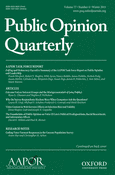-
Views
-
Cite
Cite
Bonnie E. Shook-Sa, Douglas B. Currivan, Joseph P. McMichael, Vincent G. Iannacchione, Extending the Coverage of Address-Based Sampling Frames: Beyond the USPS Computerized Delivery Sequence File, Public Opinion Quarterly, Volume 77, Issue 4, Winter 2013, Pages 994–1005, https://doi.org/10.1093/poq/nft041
Close - Share Icon Share
Abstract
Because of rising data-collection costs associated with in-person surveys, address-based sampling (ABS) is being explored as an alternative to traditional field enumeration (FE). This has led surveys such as the National Survey on Drug Use and Health (NSDUH), which relies solely on FE, to investigate the use of ABS as a potential sampling frame. Before 2009, ABS frames were restricted to the Computerized Delivery Sequence (CDS) file, which the United States Postal Service (USPS) makes available through licensing agreements with qualified vendors. Research based on the CDS has found the coverage of ABS frames for in-person surveys to be sufficient in urban areas but problematic in rural areas. Since 2009, the USPS has also made available the No-Stat file. A supplement to the CDS file, the No-Stat file contains approximately seven million predominantly rural addresses, most of which are not currently receiving mail directly and are not found in the CDS. One component of evaluating ABS for the NSDUH was to explore the potential added coverage and the cost-effectiveness of using the No-Stat file as a supplemental address source. We matched a nationally representative sample of households eligible for the 2010 NSDUH to commercially available versions of the CDS and No-Stat files and found that the No-Stat file provides an approximately four-percentage-point increase in coverage in rural areas without significantly reducing sampling efficiency.





